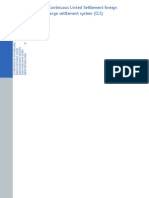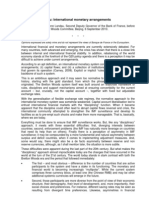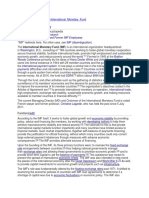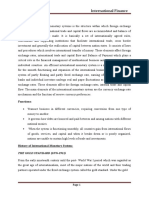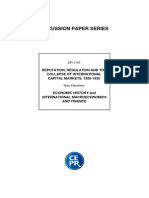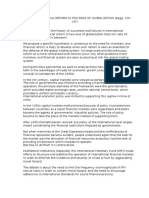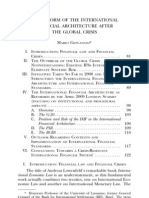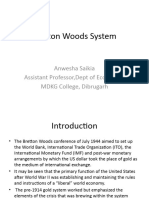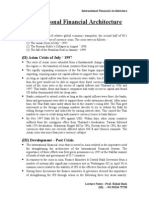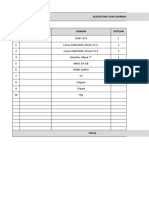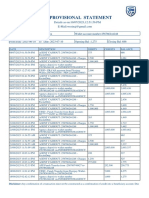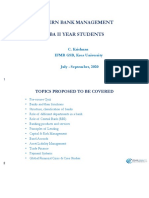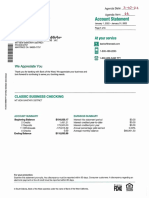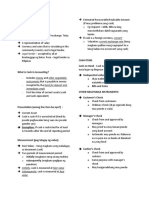CLS Group
CLS Group (for Continuous Linked Settlement), or
CLS Group
simply CLS, is a specialized financial market
infrastructure group whose main entity is the New
York-based CLS Bank. It started operations in 2002
and operates a unique and global central multicurrency
cash settlement system, known as the CLS System,
which plays a critical role in the foreign exchange
market (also known as forex or FX). Although the
forex market is decentralised and has no central
exchange or clearing facility, firms that chose to use
CLS to settle their FX transactions can mitigate the
settlement risk associated with their trades.[1] CLS
CLS Bank is headquartered at One Financial
achieve this thanks to a central net (bilateral and
Square (center) in Lower Manhattan
multilateral clearing) and gross payment versus
payment settlement service directly connected to the Industry Financial services
real-time gross settlement systems of participating Founded July 1997
jurisdictions through accounts at each of their Headquarters Lucerne (holding),
respective central banks. New York (bank)
Area served 18 currency jurisdictions
CLS demonstrated its risk-mitigation value in the
www.cls-group.com (http://w
financial crisis of 2007–2008, during which the forex Website
ww.cls-group.com)
market remained orderly even in times of severe
systemic financial stress,[2] and again during market
turmoil associated with the COVID-19 pandemic in early 2020.[3] The CLS System's sophisticated
payment versus payment concept does not entirely eliminate forex settlement risk, but reduces it
considerably among the currencies that it encompasses.[4]
History
Background
The creation of CLS was a delayed collective response to the turmoil that followed the failure of
Germany's Herstatt Bank on 26 June 1974, which highlighted the counterparty risk inherent in the system
of multilateral net settlement through which forex transactions were executed at the time. Over the three
days following Herstatt's demise, the amount of gross funds transferred by that system declined by about
60 percent.[5]: 55 The core challenge resulted from the practice of settling each leg of a forex transaction
independently, and often at different times with a lag, in the country of issue of each currency. Banks
often waited three days or more before they knew with certainty that they had received the currency they
had bought in a given such transaction.[5]: 56 The risk of paying out the currency sold but not receiving
the currency bought became known as "Herstatt risk" as well as foreign exchange settlement risk,
�comprising aspects of both credit risk and liquidity risk.[5]: 57 Similar concerns emerged again following
the collapse of Drexel Burnham Lambert in 1989, Bank of Credit and Commerce International in 1991,
the 1991 Soviet coup d'état attempt, and the collapse of Barings Bank in 1995.[6]: 34-38
Creation
In reaction to these events and following discussion among the G10 central banks, the Bank for
International Settlements (BIS) formed successive committees to address the international settlement risk
problem, namely the Group of Experts on Payment Systems and the Committee on Interbank Netting
Schemes of the Central Banks of the G10 Countries, which in 1990 were replaced by the Committee on
Payment and Settlement Systems (CPSS).[6]: 38 A series of reports by these groups paved the way towards
the creation of CLS, each named after the official who chaired the committee that prepared it:[6]: 38-44
the "Angell Report" on Netting Schemes (1989), named after US Federal Reserve
policymaker Wayne Angell, described the various kinds of internationally related financial
netting arrangements;
the "Lamfalussy Report" of the Committee on Interbank Netting Schemes (1990), named
after BIS policymaker Alexandre Lamfalussy (and not to be confused with the separate
Lamfalussy Report of 2001 which initiated the Lamfalussy process in the European Union),
identified minimum standards for the design and operation of cross-border and multi-
currency netting schemes, as well as core principles for co-operative central bank oversight
of netting system that were to shape the oversight concept for CLS;[7]: 15
the "Noël Report" of the CPSS on Central Bank Payment and Settlement Services with
Respect to Cross-Border and Multi-Currency Transactions (1993), named after Bank of
Canada policymaker Timothy Noël, analyzed the advantages and disadvantages of different
central bank services related to payment and settlement systems, without however
recommending a single preferred service option;[8]: 7
the "Allsopp Report" of the CPSS on Settlement Risk in Foreign Exchange Transactions
(1996), named after for Bank of England policymaker Christopher Allsopp, extensively
described the past episodes, such as the Herstatt failure, and called on the private sector to
find practical solutions to remedy the identified risks, and thus represented "a wake-up call
for the [banking] industry" that set the basis for subsequent initiatives including
CLS.[6]: 44, 143 [7]: 15
Such initiatives also initially included FXNet, which netted trades each day by counterparty pair; the
Exchange Clearing HOuse Ltd (ECHO), a London-based multilateral netting system which started
operations in August 1995;[5]: 59 [6]: 56 and Multinet International Bank, a New York State-chartered bank
that similarly developed a multilateral forex netting clearing house.[9] Such entities, however, had no
direct access to central bank currency, and struggled to achieve critical mass.
Like FXNet, ECHO and Multinet, CLS was established as a private-sector project, even though the
impetus came from the central banking community through the CPSS; the project turned out to be highly
complex, nearly foundered on several occasions, and at such points required intervention by the BIS to
survive.[6]: 143 In October 1994, senior executives from large international banks formed the "group of
20" or G20 (not to be confused with the G20 group of jurisdictions, which was formed in 1999) as a
common interest group.[6]: 47 Pressure from the central banks, including the publication of the Allsopp
report in 1996, led the G20 to meet regularly and focus on a common solution to reduce foreign-
exchange-related credit risk. In January 1996, it converged on the solution of a clearing bank operating a
payment versus payment mechanism with continuous real-time linked processing and item-by-item
settlement, thus the name CLS - meaning that the two legs of a foreign-exchange transaction are settled
�simultaneously.[5]: 60 By the spring of 1997, the G20 banks determined that the future system should rely
on a central bank account and membership in the respective real-time gross settlement system in each
jurisdiction (known in the payments jargon as a nostro relationship), but no physical presence other than
in the United States, United Kingdom, and Japan in order to save costs.[6]: 61 This required ad hoc
legislation to be passed in participating countries, and also the extension of operating hours in Australia,
Canada and Japan.[6]: 55
On 1 July 1997, the G20 banks jointly established CLS Services Ltd in the UK as the project's first
dedicated legal entity; other banks were asked for USD 1 million each to join the project as shareholders,
as the project building costs were rapidly increasing from an initial estimate of $40m at end-1995.[6]: 50 In
July 1998, the project had reached an ownership of 60 shareholders in 14 countries, with total
commitments of $160m.[6]: 60 On 1 November 1999, CLS Bank International was established as a New
York Edge Act financial institution after the Federal Reserve approved its application, which had been
filed on 6 August 1999.[6]: 61
In 1996 and 1997, various forms of cooperation were considered between the G20's CLS project and the
competing initiatives of FXNet, ECHO and Multinet,[6]: 56 eventually resulting in the latter initiatives' full
acquisition by CLS Services in December 1997.[6]: 58 [8]: 8 ECHO's service was discontinued in April
1999, and Multinet was dissolved in May 2000.[6]: 59-60 In April 1998, IBM was selected to develop the
CLS technical infrastructure.[10] CLS Bank started operating on 9 September 2002, settling the Australian
dollar, Canadian dollar, euro, Japanese Yen, Swiss franc, Pound sterling, and US dollar.[6]: 65
Lawrence M. Sweet, an official at the Federal Reserve Bank of New York seconded at the BIS from 1994,
was instrumental in the elaboration of the CLS concept as secretary, then chair of the CPSS Steering
Group on Foreign Exchange Settlement Risk. He also chaired the CLS Oversight Committee from its
formation in 2009 until June 2018.[11]
Later development
The original seven currencies were joined by the Danish krone, Norwegian krone, Singapore dollar and
Swedish krona in September 2003; the Hong Kong dollar, South Korean won, New Zealand dollar and
South African rand in December 2004; the Israeli shekel and Mexican peso in May 2008;[12] and the
Hungarian forint in November 2015.[13]
Since it began operations in 2002, CLS has rapidly increased and by March 2017 was settling just over
50% of global FX transactions.[14] As a result, the Financial Stability Oversight Council (FSOC)
officially designated CLS a systemically important financial market utility in July 2012.[15]
The single day record for value settled is US$15.4 trillion, set on 15 December 2021. The single day
record for volume settled is 3.2 million trades, set on 5 July 2022. [16]
�The CLS membership and shareholder base has grown accordingly, from 39 members at inception in
2002 to 79 shareholders including 66 settlement members and 24,000+ third-party clients as of
September 2017.
Group organization
Legal structure
Partly as a consequence of the need for consensus among participating central banks, the CLS Group
structure involves entities in several countries. Since 2001,[6]: 61-62 the group's parent company has been
CLS Group Holdings AG in Lucerne, a Swiss private holding company. It owns 100 percent of CLS UK
Intermediate Holdings Ltd in London (the original CLS company established in 1997 as CLS Services
Ltd and renamed in 1999),[6]: 71 which in turn owns two main subsidiaries: CLS Bank International, a
U.S. Edge Act corporation, and CLS Services Ltd, a British company that provides operational support to
CLS Bank and associated institutions.[7]: 16 The only other jurisdictions where CLS is established are
Japan and Hong Kong.[17]
Shareholders
CLS Group is a commercial entity that is operated on a not-for-profit basis, similarly as the Depository
Trust & Clearing Corporation. Its shareholders have governance rights but do not gain dividend income
or an increase in the value of their shares from retained earnings. As of 2022, CLS's website disclosed 79
banks from multiple jurisdictions as its shareholders.[18]
Supervision and oversight
CLS Group Holdings AG, while a Swiss entity, is regulated and supervised by the Federal Reserve as a
bank holding company in the United States.[6]: 71 The Federal Reserve also regulates CLS Bank
International, which it supervises as a bank. Under the unique concept initially defined in the Lamfalussy
Report of 1990, the central banks of issue of the currencies (other than the US dollar) that settle in the
CLS system are involved in the group's "oversight" but without a regulatory or supervisory mandate; the
Federal Reserve Board, supported by the Federal Reserve Bank of New York, is the "primary overseer" of
CLS Group and CLS Bank, a role it exercises in consultation with the other participating central
banks.[7]: 21, 25 The CLS Oversight Committee was formed by the participating central banks in 2009,
succeeding earlier committee formats,[11] and operates under a Protocol finalized in December 2015.[19]
As of 2022, the CLS Oversight Committee has 23 members: the respective central banks of issue of the
18 CLS currencies, plus five national banks of the Eurosystem that are also members of the G10, namely
those of Belgium, France, Germany, Italy, and the Netherlands.
Leadership
The management of CLS Bank is based in New York.[6]: 71 The CEO of CLS Group and CLS Bank has
been, successively, Joseph De Feo (2000-2005), Rob Close (2005-2010), Alan Bozian (June 2010-2012),
David Puth (August 2012-December 2019), and Marc Bayle de Jessé (since December 2019).
�The boards of both CLS Group and CLS bank have been chaired, successively, by Suzanne Labarge (June
2001-June 2003), Fritz Klein (June 2003-2005), Mark Garvin (2005-June 2007),[20] Gerard Hartsink
(2007-October 2014), Ken Harvey (October 2014-June 2022),[21] and Gottfried Leibbrandt (since June
2022).[22]
Operations
CLS operates a payment versus payment (PvP) settlement service which mitigates settlement risk for the
foreign-exchange transactions of its settlement members and their customers (third parties). CLS Bank is
connected to the real-time gross settlement systems of participating jurisdictions and holds accounts at
their respective central banks, typically enabled (outside of the United States) by ad hoc legislation that
exempts CLS from local establishment requirements. As such, CLS Bank is connected to Fedwire in the
United States, TARGET2 in the euro area, CHAPS in the United Kingdom, SIC in Switzerland, the
Reserve Bank Information and Transfer System (RITS) through the SWIFT Payment Delivery Service in
Australia, KRONOS in Denmark, CHATS in Hong Kong, BOJ-NET in Japan, BOK-Wire in South
Korea, ESAS in New Zealand, Norges Bank Settlement System (NBO) in Norway, MEPS+ in Singapore,
SAMOS in South Africa, RIX in Sweden, etc.[6]: 17–21
CLS operates a global multi-currency cash settlement system through which settlement risk can be
mitigated with finality using a combination of PvP (payment versus payment) settlement over CLS
central bank accounts, local real-time gross settlements systems (RTGS) and multilateral payment netting
supported by a resilient infrastructure.[23]
In a PvP system both sides’ payment instructions for an FX transaction are settled simultaneously.
Without PvP there is a serious risk that one party to an FX transaction will deliver the currency it owes,
but not receive the other currency from its counterparty, resulting in the loss of principal. This is known
as settlement risk, or “Herstatt Risk”, after the German bank, Bankhaus Herstatt, which collapsed in June
1974 leaving many of its FX counterparties with significant losses.[24] In 1995 the Bank for International
Settlements presented a possible solution on a PvP basis.[25] In an advancement to this proposal the G20
banks founded an earmarked financial institute, the CLS Bank International.[26]
Following an FX transaction, settlement members submit payment instructions to CLS. These
instructions are authenticated and matched by CLS and maintained by the system until settlement date.
The CLS daily settlement cycle operates with settlement and funding occurring during a five-hour
window when all real-time gross settlement (RTGS) systems in the CLS settlement currency jurisdictions
are open and able to make and receive payments. This enables simultaneous settlement of the payments
on both sides of an FX transaction.
Each settlement member holds a single multi-currency account with CLS. At the start and end of a normal
settlement day, each settlement member has a zero balance on its account. Under normal operations of the
settlement service, CLS starts and ends the day with a zero balance in its central bank accounts and in its
settlement member accounts. Settlement members may submit instructions relating to their own FX
transactions as well as the FX transactions of their third-party customers directly to CLS.
CLS holds accounts with each of the central banks whose currencies it settles.
�On each settlement date, upon determining that the accounts of the submitting settlement members satisfy
several risk management tests, CLS simultaneously settles each pair of matched payment instructions by
making the corresponding debit and credit entries in the settlement members’ accounts at CLS. The
settlement of the payment instructions and the associated payments are final and irrevocable.
For example, (GBP/USD = 1.50, EUR/USD = 1.25):[27]
By trades:
Member 1: Buys 1,000 GBP/USD from Member 2
Member 2: Buys 1,000 EUR/USD from Member 3
Member 3: Buys 1,000 GBP/USD from Member 1
By currency positions:
Member 1: Owes USD1500 and GBP1000, collects USD1500 and GBP1000
Member 2: Owes USD1250 and GBP1000, collects EUR1000 and USD1500
Member 3: Owes USD1500 and EUR1000, collects USD1250 and GBP1000
CLS then multi-laterally nets the total obligations:
Member 1: Pays 0.0 and receives 0.0
Member 2: Pays GBP1000, and receives EUR1000 and USD250
Member 3: Pays USD250 and EUR1000, and receives GBP1000
These obligations are funded into and from each member’s respective multi-currency account.
Another key element of the CLS Settlement Service is the liquidity efficiencies delivered through
multilateral payment netting. On each day participants will very likely have more than one trade to settle
—in practice, major banks will have hundreds or thousands of trades each day. Each day prior to
settlement, CLS calculates the funding required of each settlement member on a multilateral netted basis.
The amount of cash required by CLS to settle all payment instructions is reduced, allowing each
settlement member to transfer only the net amount of its payment obligations in each currency, rather
than the total amount of each trade to be settled. On average, CLS netting efficiency is in the region of 96
percent.
In addition to the usual settlement service, the in/out swap process[28] is done before the settlement
windows to reduce the payment obligations to CLS and to mitigate liquidity pressures. An in/out swap is
an intraday swap consisting of two equal and opposite FX transactions that are agreed as an intraday
swap.
One of the “legs” is settled inside CLS in order to reduce each settlement member’s net position in the
two relevant currencies. The other “leg” is settled outside CLS.
The in/out swap further compresses payment obligation by an average of 75%, which results in a funding
requirement in CLS of less than 1% of the total gross settlement value.
CLS currencies
CLS has expanded the number of currencies it settles over the years and currently (mid-2022) settles:
� Country/entity Symbol Currency
Australia AUD Australian dollar
Canada CAD Canadian dollar
Denmark DKK Danish krone
Eurozone EUR Euro
Hong Kong HKD Hong Kong dollar
Hungary HUF Hungarian forint
Israel ILS Israeli new shekel
Japan JPY Japanese yen
Mexico MXN Mexican peso
New Zealand NZD New Zealand dollar
Norway NOK Norwegian krone
Singapore SGD Singapore dollar
South Africa ZAR South African rand
South Korea KRW South Korean won
Sweden SEK Swedish krona
Switzerland CHF Swiss franc
United Kingdom GBP Pound sterling
United States USD United States dollar
See also
SWIFT
References
Notes
1. Michael R. King; Dagfinn Rime (December 2010), "The $4 trillion question: what explains FX
growth since the 2007 survey?" (http://www.bis.org/publ/qtrpdf/r_qt1012e.pdf) (PDF), BIS
Quarterly Review
2. Richard Levich (10 July 2009). "Why foreign exchange transactions did not freeze up during
the global financial crisis: The role of the CLS Bank" (https://voxeu.org/article/clearinghouse-
saved-foreign-exchange-trading-crisis). VoxEU.
3. Julien Sabet (3 November 2020). "The Foreign Exchange market in 2020: three benefits of
Continuous Linked Settlement (CLS)" (https://securities.cib.bnpparibas/the-foreign-exchang
e-market-in-2020-three-benefits-of-continuous-linked-settlement-cls/). BNP Paribas.
4. Ben Norman (24 June 2015). "BoE archives reveal little known lesson from the 1974 failure
of Herstatt Bank" (https://bankunderground.co.uk/2015/06/24/boe-archives-reveal-little-know
n-lesson-from-the-1974-failure-of-herstatt-bank/). Bank Underground. Bank of England.
� 5. Gabriele Galati (December 2002), "Settlement risk in foreign exchange markets and CLS
Bank" (https://www.bis.org/publ/qtrpdf/r_qt0212f.pdf) (PDF), BIS Quarterly Review, Bank for
International Settlements
6. Alexandra Schaller (2007), Continuous linked settlement: history and implications (https://w
ww.zora.uzh.ch/id/eprint/163690/1/20080261.pdf) (PDF), University of Zurich, Faculty of
Economics
7. Paul Miller; Carol Ann Northcott (Autumn 2002). "CLS Bank: Managing Foreign Exchange
Settlement Risk" (https://www.bankofcanada.ca/wp-content/uploads/2010/06/miller_e.pdf)
(PDF). Bank of Canada Review.
8. Charles M. Kahn; William Roberds (2000), The CLS Bank: a solution to the risks of
international payments settlement? (https://www.econstor.eu/bitstream/10419/100786/1/wp2
000-15a.pdf) (PDF), Federal Reserve Bank of Atlanta
9. "Multinet Set To Launch Forex Netting Service" (https://www.risk.net/risk-management/settle
ment-risk/1507612/multinet-set-launch-forex-netting-service). Risk.net. 22 April 1996.
10. "IBM To Build CLS's Continuous Linked Forex Settlement Service" (https://www.risk.net/risk-
management/settlement-risk/1506834/ibm-to-build-clss-continuous-linked-forex-settlement-s
ervice). Risk.net. 4 May 1998.
11. "Lawrence M. Sweet" (https://www.tchbpiconference.com/speakers/detail/?speaker=Lawren
ce%20M%20Sweet). The Clearing House and Bank Policy Institute Annual Conference.
12. "The Continuous Linked Settlement foreign exchange settlement system (CLS)" (https://ww
w.snb.ch/en/mmr/reference/continuous_linked_settlement/source/continuous_linked_settle
ment.en.pdf) (PDF). Swiss National Bank. November 2009.
13. "CLS settlement" (https://www.mnb.hu/en/payments/settlement-systems/cls-settlement#:~:te
xt=Following%20the%20cooperation%20between%20the,financial%20infrastructure%20ope
rated%20by%20CLS.). Magyar Nemzeti Bank.
14. "Daily FX trade more like $3 trillion than 5 -CLS" (https://www.cnbc.com/2017/03/13/reuters-
america-daily-fx-trade-more-like-3-trillion-than-5-cls.html?view=story&%24DEVICE%24=nati
ve-android-mobile). CNBC. Retrieved 2017-03-13.
15. "Financial Stability Oversight Council Makes First Designations in Effort to Protect Against
Future Financial Crises" (http://www.treasury.gov/press-center/press-releases/Pages/tg164
5.aspx). treasury.gov. Retrieved 2012-10-18.
16. "CLS celebrates 20-year anniversary" (https://e-forex.net/cls-celebrates-20-year-anniversar
y/). E-Forex. 2022-09-21. Retrieved 2022-10-07.
17. "Our offices" (https://www.cls-group.com/contact-us/). CLS.
18. "CLS Group Holdings AG - List of Shareholders" (https://www.cls-group.com/media/yllbhrfe/
cls-group-shareholders-list_feb2022.pdf) (PDF). CLS. February 2022.
19. "Protocol for the Cooperative Oversight Arrangement of CLS" (https://www.federalreserve.g
ov/paymentsystems/files/cls_protocol.pdf) (PDF). U.S. Federal Reserve. 10 December
2015.
20. Frances Maguire (25 June 2003). "CLS appoints new chairman and vice-chairman" (https://
www.fnlondon.com/amp/articles/cls-appoints-new-chairman-and-vice-chairman-20030625).
Financial News.
21. "Ken Harvey to succeed Gerard Hartsink as Chairman" (https://www.cls-group.com/news/ke
n-harvey-to-succeed-gerard-hartsink-as-chairman/). CLS. 3 March 2014.
22. Colin Lambert (1 June 2022). "CLS Gets New Chair, Directors" (https://thefullfx.com/cls-gets
-new-chair-directors/). The Full FX.
23. "CLS Settlement" (https://www.cls-group.com/products/settlement/clssettlement/). Cls-
group.com. Retrieved 2012-06-30.
24. Bank Failures in Mature Economies (http://www.bis.org/publ/bcbs_wp13.htm), Basel
Committee on Banking Supervision, April 2004, retrieved 2012-06-30
�25. Bank for International Settlements, Payment systems in countries of the Group of Ten, 1995,
page 551
26. Bank for International Settlements, Quarterly report December 2002, page 69.
27. "CLS Bank & the World of FX Settlement" (http://forexmagnates.com/cls-bank-the-world-of-f
x-settlement/). Forex Magnates. Retrieved 2014-06-14.
28. "In/Out Swaps" (http://www.cls-group.com/ProdServ/Pages/InOutSwaps.aspx). CLS.
Retrieved 2014-06-14.
External links
CLS website (http://www.cls-group.com)
Retrieved from "https://en.wikipedia.org/w/index.php?title=CLS_Group&oldid=1255044956"





